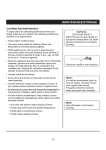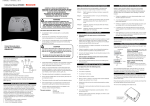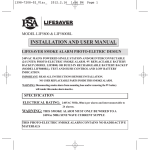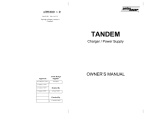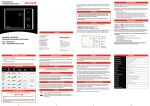Download Trouble Shooting Guide for Residential Smoke Alarms
Transcript
Trouble Shooting Guide for Residential Smoke Alarms False alarms can result from a wide variety of causes. Some of the most common causes are listed below. If a smoke alarm has issued an apparent false alarm, but appears to be operating normally, check the recommended solution for each alarm cause. Improper Siting and Location: False alarms can occur in areas with temperature extremes, excessive dust, dirt or humidity; excessive air flow rates; or the presence of combustion particles, vapours, gases, or fumes in air streams surrounding the alarm. Could there be visible or invisible particles in the air flow: chemicals, cleaning materials, fuels etc? (ie. Cooking fumes, toast fumes, paint). Does cooking, smoking, or an activity that uses a combustion process (like heating) occur near the alarm or where an air current that flows near the alarm can transport combustion particles to the alarm location? Is there rapid air movement around the false alarm? Is the alarm close to windows, a door or an air vent? A suddenly opened or closed window or door can momentarily cause high air velocities. Improper Installation: False alarms can occur where the smoke alarm wiring is not protected from interference from fluorescent lights, induced currents and noise in adjacent wiring systems, radio frequency transmissions and other types of electromagnetic effects. Are smoke alarms installed too close to fluorescent lighting or other apparatus capable of emitting electromagnetic effects? Inadequate Maintenance: Inadequate maintenance will result in the accumulation of dust and dirt on the alarm’s sensing chamber over a period of time resulting in increasing false alarms. Is the environment around the alarm dusty or dirty? Seasonal Effects: Seasonal effects such as alarms that occur during the re-activating of the building heating system after an extended summer shutdown and the dust accumulated on the heating coils is burned off can result in false alarms. Is the environment excessively humid? Do rapid changes in humidity or concentration of water droplets occur? (ie. Steam from laundry, bathroom or kitchen). Insect Infestation: From bugs small enough to enter the alarm’s sensing chamber. Are there insects near or around the alarm? When tiny insects get into an alarm’s sensing chamber they can cause an alarm response. START ALARM CONTINUALLY INTERMITTENTLY CHIRPS IS BATTERY INSERTED CORRECTLY WITH CORRECT POLARITY? NO INSERT BATTERY CORRECTLY NO REPLACE WITH NEW BATTERY AS PER SMOKE ALARM SPECIFICATIONS NO REPLACE WITH NEW BATTERY AS PER SMOKE ALARM SPECIFICATIONS YES IS BATTERY FRESH WITH THE CORRECT SPECIFICATIONS? YES IS SMOKE ALARM IN HUSH MODE? YES ALARM WILL RESET IN 8-10 MINUTES IF NOT SATISFIED PLEASE CONTACT PSA PRODUCTS FOR TECHNICAL SUPPORT START SMOKE ALARM DOES NOT OPERATE IS POWER SUPPLY CONNECTED? CHECK POWER ON LED NO CONNECT POWER NO REPLACE WITH A PSA/LIFESAVER SMOKE ALARM NO CLEAN UNIT THOROUGHLY SEE USER MANUAL NO REPLACE WITH A PSA/LIFESAVER SMOKE ALARM YES TEST THE TEST BUTTON ON THE UNIT. DOES UNIT NOW OPERATE? YES HAS THE UNIT BEEN RECENTLY CLEANED? YES UNIT IS NOW OPERATING OK? IF NOT SATISFIED PLEASE CONTACT PSA PRODUCTS FOR TECHNICAL SUPPORT START ALARM CONTINUALLY NUISANCE ALARMING IS INSTALLATION NEAR COOKING FUMES, PAINT FUMES OR STEAM? YES RELOCATE ALARM OR REPLACE WITH A PSA/LIFESAVER PHOTOELECTRIC SMOKE ALARM YES RELOCATE ALARM OR REPLACE WITH A PSA/LIFESAVER PHOTOELECTRIC SMOKE ALARM YES RELOCATE ALARM OR REPLACE WITH A PSA/LIFESAVER PHOTOELECTRIC SMOKE ALARM YES SMOKE ALARM REQUIRES THOROUGH CLEANING YES FUMIGATE AREA AND THOROUGHLY CLEAN ALARM NO IS INSTALLATION IN AIR STREAMS THAT MAY CAUSE COOKING FUMES, PAINT FUMES ETC? NO IS THE ALARM ALARMING WHEN COOKING TAKES PLACE? NO HAS ALARM BEEN EXPOSED TO DUST, SANDING OR BEEN INSTALLED FOR SOME TIME WITHOUT PROBLEMS? NO ARE THERE INSECTS AROUND THE ALARM? I.E. BUGS, SPIDERS ETC. NO REPLACE WITH A PSA/LIFESAVER SMOKE ALARM




